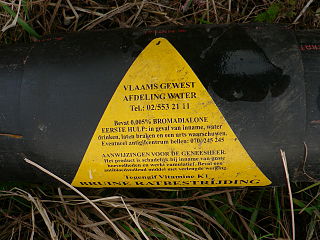
Vitamin K refers to structurally similar, fat-soluble vitamers found in foods and marketed as dietary supplements. The human body requires vitamin K for post-synthesis modification of certain proteins that are required for blood coagulation or for controlling binding of calcium in bones and other tissues. The complete synthesis involves final modification of these so-called "Gla proteins" by the enzyme gamma-glutamyl carboxylase that uses vitamin K as a cofactor.

The prothrombin time (PT) – along with its derived measures of prothrombin ratio (PR) and international normalized ratio (INR) – is an assay for evaluating the extrinsic pathway and common pathway of coagulation. This blood test is also called protime INR and PT/INR. They are used to determine the clotting tendency of blood, in such things as the measure of warfarin dosage, liver damage, and vitamin K status. PT measures the following coagulation factors: I (fibrinogen), II (prothrombin), V (proaccelerin), VII (proconvertin), and X.

Megaloblastic anemia is a type of macrocytic anemia. An anemia is a red blood cell defect that can lead to an undersupply of oxygen. Megaloblastic anemia results from inhibition of DNA synthesis during red blood cell production. When DNA synthesis is impaired, the cell cycle cannot progress from the G2 growth stage to the mitosis (M) stage. This leads to continuing cell growth without division, which presents as macrocytosis. Megaloblastic anemia has a rather slow onset, especially when compared to that of other anemias. The defect in red cell DNA synthesis is most often due to hypovitaminosis, specifically vitamin B12 deficiency or folate deficiency. Loss of micronutrients may also be a cause.

Dermatographic urticaria is a skin disorder and one of the most common types of urticaria, affecting 2–5% of the population.

Hypervitaminosis A refers to the toxic effects of ingesting too much preformed vitamin A. Symptoms arise as a result of altered bone metabolism and altered metabolism of other fat-soluble vitamins. Hypervitaminosis A is believed to have occurred in early humans, and the problem has persisted throughout human history. Toxicity results from ingesting too much preformed vitamin A from foods, supplements, or prescription medications and can be prevented by ingesting no more than the recommended daily amount.

Hypoprothrombinemia is a rare blood disorder in which a deficiency in immunoreactive prothrombin, produced in the liver, results in an impaired blood clotting reaction, leading to an increased physiological risk for spontaneous bleeding. This condition can be observed in the gastrointestinal system, cranial vault, and superficial integumentary system, affecting both the male and female population. Prothrombin is a critical protein that is involved in the process of hemostasis, as well as illustrating procoagulant activities. This condition is characterized as an autosomal recessive inheritance congenital coagulation disorder affecting 1 per 2,000,000 of the population, worldwide, but is also attributed as acquired.

Phenprocoumon is a long-acting blood thinner drug to be taken by mouth, and a derivative of coumarin. It acts as a vitamin K antagonist and inhibits blood clotting (coagulation) by blocking synthesis of coagulation factors II, VII, IX and X. It is used for the prophylaxis and treatment of thromboembolic disorders such as heart attacks and pulmonary (lung) embolism. The most common adverse effect is bleeding. The drug interacts with a large number of other medications, including aspirin and St John's Wort. It is the standard coumarin used in Germany, Austria, and other European countries.

Acenocoumarol is an anticoagulant that functions as a vitamin K antagonist. It is a derivative of coumarin and is generic, so is marketed under many brand names worldwide.

4-Hydroxycoumarins belong to a class of vitamin K antagonist (VKA) anticoagulant drug molecules derived from coumarin by adding a hydroxy group at the 4 position to obtain 4-hydroxycoumarin, then adding a large aromatic substituent at the 3-position. The large 3-position substituent is required for anticoagulant activity.

Brodifacoum is a highly lethal 4-hydroxycoumarin vitamin K antagonist anticoagulant poison. In recent years, it has become one of the world's most widely used pesticides. It is typically used as a rodenticide, but is also used to control larger pests such as possum.

Tioclomarol is an anticoagulant of the 4-hydroxycoumarin vitamin K antagonist type. It is a second generation drug, used as a rodenticide that is effective for the control of rodents that are resistant to this class of drugs.

Ethyl biscoumacetate is a vitamin K antagonist.

Bromadiolone is a potent anticoagulant rodenticide. It is a second-generation 4-hydroxycoumarin derivative and vitamin K antagonist, often called a "super-warfarin" for its added potency and tendency to accumulate in the liver of the poisoned organism. When first introduced to the UK market in 1980, it was effective against rodent populations that had become resistant to first generation anticoagulants.

Allithiamine (thiamine allyl disulfide or TAD) is a lipid-soluble form of vitamin B1 which was discovered in garlic (Allium sativum) in the 1950s along with its homolog prosultiamine. They were both investigated for their ability to treat Wernicke–Korsakoff syndrome and beriberi better than thiamine.
Vitamin K deficiency results from insufficient dietary vitamin K1 or vitamin K2 or both.

Difenacoum is an anticoagulant of the 4-hydroxycoumarin vitamin K antagonist type. It has anticoagulant effects and is used commercially as a rodenticide. It was first introduced in 1976 and first registered in the USA in 2007.

Vitamin K antagonists (VKA) are a group of substances that reduce blood clotting by reducing the action of vitamin K. The term "vitamin K antagonist" is technically a misnomer, as the drugs do not directly antagonise the action of vitamin K in the pharmacological sense, but rather the recycling of vitamin K.

Flocoumafen is a fluorinated, second-generation anticoagulant of the 4-hydroxycoumarin vitamin K antagonist type. It is a second generation chemical in this class, used commercially as a rodenticide. It has a very high toxicity and is restricted to indoor use and sewers. This restriction is mainly due to the increased risk to non-target species, especially due to its tendency to bio-accumulate in exposed organisms. Studies have shown that rodents resistant to first-generation anticoagulants can be adequately controlled with flocoumafen. It was synthesized in 1984 by Shell International Chemical.
An endocrine bone disease is a bone disease associated with a disorder of the endocrine system. An example is osteitis fibrosa cystica.

Vitamin K2 or menaquinone (MK) is one of three types of vitamin K, the other two being vitamin K1 (phylloquinone) and K3 (menadione). K2 is both a tissue and bacterial product (derived from vitamin K1 in both cases) and is usually found in animal products or fermented foods.

















